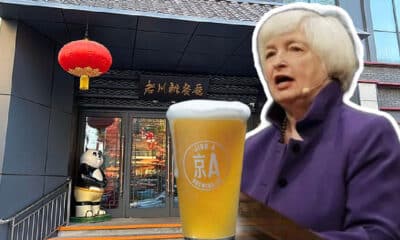China Brands, Marketing & Consumers
China’s XR Development 101: How Chinese Tech Giants are Navigating Towards the Metaverse
Chinese tech giants are massively investing in virtual reality and in the technologies that are building up the Chinese metaverse.
Published
1 year agoon
By
Jialing Xie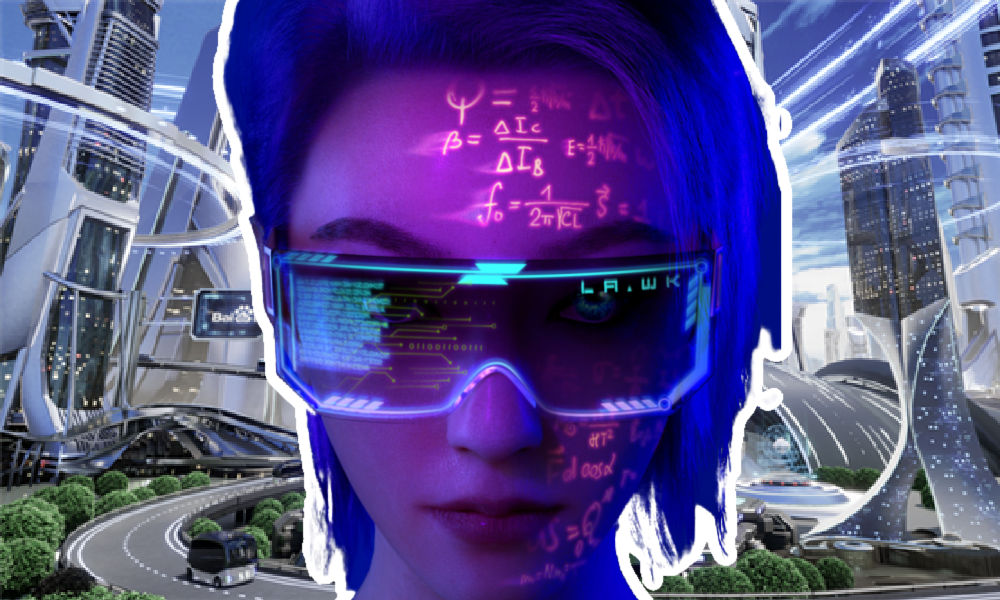
Virtual, Augmented, and Mixed Reality technologies are blurring the lines between the real and digital worlds and are powering the metaverse. Chinese tech giants are at the forefront of the latest developments on the mainland market, including XR, that are making the metaverse possible. Time for a round-up of what China’s key players are focusing on and which virtual initiatives are already live.
2021 is the year in which the concept of ‘metaverse’ has blossomed. In March of last year, the hugely successful online multiplayer game and game creation system Roblox went public with a market value of over $41 billion at the time, earning its reputation as the world’s first metaverse IPO.
Following the release of the 2021 sci-fi comedy Free Guy – which is set in a fictional metaverse-like video game, – and Facebook’s rebranding to ‘Meta’ last fall, ‘metaverse’ became one of the hottest buzzwords on the internet.
The term metaverse is actually decades old. In the 1981 novel True Names, the American computer scientist Vernor Steffen Vinge already envisioned a virtual world that could be accessed through a brain-computer interface, and the term ‘metaverse’ was first mentioned in the 1992 Snow Crash science fiction novel by Neal Stephenson.
Now, 5G, AI, VR, Blockchain, 3D modeling, and other new technologies converged on the concept of the metaverse industry are seeing an explosive growth in China.
At the recent 20th Party Congress, it became clear once again that the digital economy is key in China’s long-term strategies, with Chinese leader Xi Jinping promoting digitalization as one of the new “engines” of future growth.
About Metaverse (元宇宙) in China
In Chinese, ‘metaverse’ is referred to as yuányǔzhòu (元宇宙), which is a literal translation of ‘meta-verse’ – meaning ‘transcending universe’ (超越宇宙). Chinese tech sources also describe the year 2021 as “the metaverse year” (元宇宙元年).
Metaverse is a collective, shared virtual realm that can interact with the real world and where people can interact with each other and the spaces around them. There is not just one single metaverse – there can be many digital living spaces referred to as the ‘metaverse.’
Metaverse is a fluid concept or virtual experience that is still developing and due to the differences in cyber regulations, digital ecosystems, and strict control on online information flows, the Chinese metaverse will unquestionably be very different from the metaverse spheres that companies such as Facebook are working on.
The metaverse is made possible through a wide range of technologies including AI, IoT, Blockchain, Interaction Technology, computer games, and network computing. XR is key to the rise of the metaverse. XR, or Extended Reality, is an umbrella term for a range of immersive technologies including VR (Virtual Reality 虚拟现实), AR (Augmented Reality 增强现实), and MR (Mixed Reality 混合现实). A 2020 Deloitte report suggests that the global XR market consists of mainly VR technologies (48% of market share), followed by AR (34%) and MR (18%).
In December of 2020, Tencent’s CEO Ma Huateng (马化腾) announced the concept of the “All-real Internet” (全真互联网) in a special internal publication regarding the company’s growth and major changes. Ma proposed that the deep integration of the virtual and real world, the “All-real Internet,” is the future opportunity to focus on as the next stage of the (mobile) internet. Although there are some subtle differences, Ma’s idea of the “All-real Internet” overlaps with the concept of the metaverse.
The metaverse, XR, and related technologies are not just a hot issue for Chinese tech companies, they are also an important theme for Chinese authorities. The 20th Party Congress was by no means the first time for China’s leadership to stress the country’s focus on the latest digital innovations. In October 2021, President Xi Jinping also spoke about evolving China’s digital economy during the 19th CPC Central Committee. He asserted that one of the focal points within the development strategy of China’s digital economy is the further integration of digital technologies and real-world economies.
This idea was further clarified in the outline of the 14th Five-Year Plan issued by the State Council at the end of 2021, which listed VR and AR as one of the seven key industries of China’s digital economy along with cloud computing, IoT, AI, and others.
Subsequently, many local governments incorporated metaverse (“元宇宙”) and related relevant terms into their respective 14th Five-Year Plans. For example, Shanghai authorities stated it will focus on the further developments of industries related to quantum computing, 3rd-gen semiconductors, 6G communications, and metaverse.
Here, we will provide an overview of XR industry development in present-day China, going over the key players Baidu, Alibaba, and Tencent (BAT) along with the younger Chinese tech giant ByteDance. We provide an overview of what they are investing in, what their respective strategies are when it comes to XR, and give examples of the kind of initiatives that they have already launched. To limit the scope of this article, we have left out Netease, Huawei, Bilibili, and some other relevant Chinese players for now (we might still make a part two later on!).
Key Players and Strategies
▶︎ BAIDU
As one of the leading artificial intelligence (AI) and internet companies in the world, Baidu specializes in internet and AI-related products and services. Baidu is mostly known as China’s number one search engine, but its ambitions go far beyond that. “We want to be like Amazon Web Services (AWS) for the metaverse,” Ma Jie (马杰), vice president at Baidu, recently said.
The company has taken a special interest in building the infrastructure to support metaverse-related projects, deviating from the strategies that focus more on the XR-related content development and distribution that you see at Tencent or Bytedance.
What’s Happening?
Investments
◼︎ iQiyi (爱奇艺), one of China’s top media streaming platforms (sometimes also referred to as the ‘Chinese Netflix’), released its all-in-one virtual reality headset ‘Adventure Dream’ in December 2021 powered by Snapdragon XR2. Baidu owns 53% of iQiyi and holds more than 90% of its shareholder voting rights.
Research & Development
◼︎ Baidu launched the ‘Baidu VR Browser’ on July 15, 2016, becoming China’s first browser powered by webVR technology.

Xirang
◼︎ In 2017, Baidu launched ‘Baidu VR’ platform, which is now offering a wide range of VR-related software and hardware products and services, including the Baidu VR Headset, VR Creation Center, AI app, and XiRang (希壤), which is referred to as China’s “first metaverse platform.”
What’s Live?
Retail
◼︎ In 2018, Baidu VR and UXin Limited, a Chinese online used car marketplace, jointly developed VR 360° interior panoramas that put viewers in the driver’s seat to see how interior details come together and to better understand the details of each vehicle such as scratches, wheels and engine models.
◼︎ Baidu’s ‘Meta Ziwu’ (元宇宙誌屋Meta ZiWU), a virtual space within XiRang, hosts various fashion shows for international brands. In August of 2022, Italian luxury fashion house Prada livestreamed its Fall 2022 collection within the interactive realms of ‘Meta Ziwu,’ and so did Dior, the French fashion house which has also launched its first-ever metaverse exhibition “On the Road” (在路上) via Meta Ziwu.
Social Networking
◼︎ In late 2021, Baidu launched its metaverse project XiRang (希壤, ‘the land of hope’) as “the first Chinese-made metaverse product.” In December, Baidu held ‘Baidu Create 2021′, a three-day annual developers’ conference in a virtual world generated by the XiRang platform, hosting 100,000 people on one set of servers at the same time. Baidu’s Vice President Ma Jie, also Head of the Metaverse XiRang project, shared that the main goal behind this project is to lay the infrastructure of the metaverse by providing developers and content creators with the tools to build their metaverse projects.

Chinese architect Ma Yansong (马岩松), founder of MAD architects, also works together with Meta Ziwu as a virtual architect.
▶︎ALIBABA
Founded in 1999, Alibaba is one of the world’s largest e-commerce and cloud computing companies in Asia Pacific. Its massive success in e-commerce also established Alibaba’s leading position in artificial intelligence and other key technologies that have supported e-commerce, as well as in the future of metaverse.
As one of the biggest venture capital firms and investment corporations in the world, Alibaba struck several deals with prominent XR companies including Magic Leap and Nreal to gain footing in the Extended Reality industry.
As for R&D, Alibaba’s ambition in becoming the world’s fifth-largest economy led to a strong emphasis on technological research and XR-focused innovation and the founding of DAMO Academy.
Within the field of XR, Alibaba primarily focuses on two aspects: underlying technology solutions (e.g. cloud computing) and XR application in its own core business model (e-commerce).
What’s Happening?
Investments
◼︎ In February 2016 and October 2017, Alibaba led the investment rounds in Magic Leap, an augmented reality firm headquartered in Florida.
◼︎ In March of this year, Alibaba led a $60 million investment round of Beijing-based augmented reality glasses maker Nreal. Nreal, founded in 2017, has since launched two AR glasses for the Chinese market: Nreal X for developers and content creators and Nreal Air for regular consumers. Nreal Air glasses have been released in Japan and the UK in February and May of this year. In addition to AR glasses, Nreal also cooperated with iQiyi, China Mobile Migu, Weilai, and Kuaishou to develop AR content.
Research & Development
◼︎ In March 2016, Alibaba announced its own VR research lab, GM LAB ( ‘GnomeMagic’ Lab), which aims to power its e-commerce platform and other subsidiary businesses such as the VR content production for its film and music platforms.
◼︎ Alibaba registered several metaverse-related trademarks, including “Ali Metaverse.”
◼︎ In 2021, Alibaba’s DAMO Academy, a global research program in cutting-edge technologies, launched ‘X Lab’ that focuses on research in key areas related to the metaverse industry, including quantum computing, XR, and xG Technology. Tan Ping (谭平), the former Head of XR Lab, shared several of their ongoing projects at the time. One example he mentioned is the virtual character Xiaomo (小莫), who is very versatile and can, among other things, convert textual information into sign language to enable smoother communication for the hearing impaired.

Xiaomo by Alibaba can turn spoken text into sign language.
‘X Lab’ is also experimenting with making history come alive through virtual initiatives. Recently, Alibaba’s cloud gaming platform Yuanjing made it possible for visitors at their Alibaba Cloud’s Apsara conference to virtually visit the Xi’an Museum and check out its artifacts via mobile phone or laptop, or to have an immersive experience of the Tang dynasty’s imperial palace complex, powered by automatic 3D space creation and visual localization technology.
What’s Live?
eCommerce
◼︎ In November 2016, Alibaba launched the Mobile BUY+ feature in Taobao mobile apps in light of its annual Single’s Day Global Shopping Festival. With VR headsets and the app, China-based Taobao shoppers could experience shopping in-store at Target, Macy’s, or Costco in the US and other malls located in countries such as Japan and Australia.
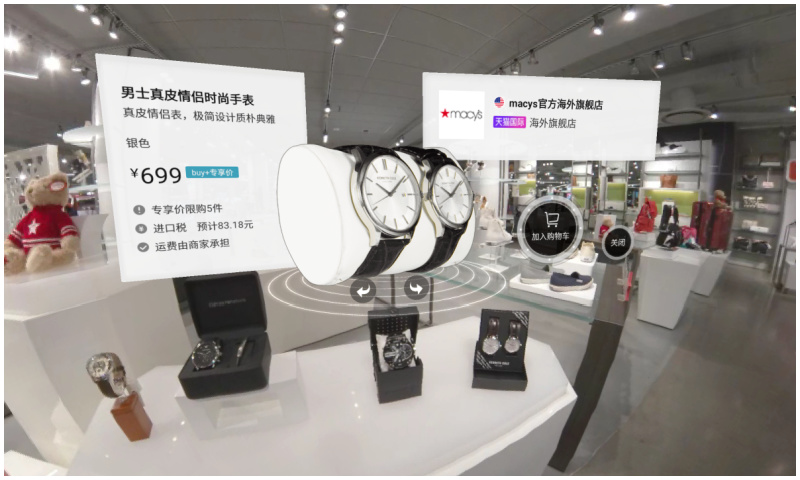
◼︎ As Alibaba constantly keeps innovating its e-commerce landscape, its research institute DAMO Academy, in collaboration with its licensing platform Alifish, rolled out an XR-powered marketplace on Alibaba’s e-commerce platforms Tmall and Taobao for its November 2022 Single’s Day festival that allows consumers to visit virtual shopping streets and shop for merchandise as their own customizable avatars.
Entertainment
◼︎ In 2021, Alibaba led a $20 million Series A financing round of DGene, a virtual reality and immersive entertainment developer. Among others, DGene creates digital influencers or can even recreate historical figures based on its AI-driven technologies.

Dong Dong was launched as the first virtual brand ambassador for the Winter Olympics in 2022.
◼︎ For the Olympic Winter Olympics in 2022, Alibaba launched Dong Dong, a digital persona developed by Damo Academy using cloud-based digital technologies. Dong Dong was able to engage with fans and online viewers through livestreams, respond to questions in real time, and she even hosted online talkshows.
▶︎TENCENT
As a multinational technology and entertainment conglomerate with the highest-grossing revenue in the world, Tencent has the financial resources to gain an upper hand in technological innovation through acquisition and investment. In 2021 alone, Tencent made a total of 76 investments in Gaming, accounting for 25.2% of Tencent’s total investment throughout the year – a 9.3% increase compared to 2020. Tencent is now the biggest gaming company in the world.
Tencent also ramped up the company’s total headcount working in R&D department by 41%, accounting for 68% of its total workforce in 2021.
Although XR is used to create immersive experiences in different industries including healthcare, manufacturing, or education, its primary fields are still gaming and social – which just so happen to be Tencent’s main focus areas. It is therefore perhaps unsurprising that Tencent, as the country’s Gaming & Social giant, has made XR part of its core business.
What’s Happening?
Investments
◼︎ In 2012, Tencent made an investment in Epic Games, the owner of Unreal Engine which powers well-known video games such as Fortnite, purchasing approximately 40% of the total Epic capital, making it the second largest shareholder. Epic Games’ major businesses span across RT3D game engine (Unreal), in-house developed games (Fortnite), and platform games. This investment is one of the reasons why Tencent conquered a leading position in the metaverse realm when it comes to games.
◼︎ As early as 2014, Tencent already tapped into the VR market by investing in social VR platform AltspaceVR, which was later acquired by Microsoft in 2017.
◼︎ In May 2019, Tencent and Roblox announced a joint venture in which Tencent holds a 49% controlling stake.
◼︎ In September of 2021, Tencent became the new investor behind Beijing-based VR game developer Vanimals (威魔纪元), known for its flagship games Undying and Eternity Warriors VR.
◼︎ In November 2021, Tencent joined the $82M Series D fundraising of Ultraleap, the world leader in mid-air haptics and 3D hand tracking. Ultraleap’s hand-tracking platform has been built into multiple platforms including Qualcomm’s XR and VR devices.
◼︎ In March 2022, Tencent invested in the Chinese AR glasses manufacturer SUPERHEXA (蜂巢科技) holding 7.3% of its shares.
Research & Development
◼︎ In 2015, Tencent announced its avant-garde VR Project ‘Tencent VR,’ a plan consisting of building its own VR games and releasing Tencent Virtual reality software development kits (VR SDKs) to support other VR game developers.
◼︎ As of September 2021, Tencent applied for registration of nearly 100 trademarks related to the metaverse, including “Tencent Music Metaverse” (腾讯音乐元宇宙).
◼︎ In June 2022, Tencent officially set up its XR department led by its Interactive Entertainment Division (IEG) game developer NExT Studios. During Tencent’s annual gaming conference SPARK 2022, the Head of IEG, Ma Xiaoyi (马晓轶), shared Tencent’s ambitions in charting all segments of the VR industry in the next 5 years, from developer software tools and SDKs to VR hardware, to consumer-facing content.
◼︎ NExT Studios, which is the youngest studio within the Tencent Games family, has partnered with the Shenzhen-based FACEGOOD, a 3D content generation technology company that is focused on building metaverse infrastructure.
What’s Live?
Gaming
◼︎ At ChinaJoy 2019, the largest gaming and digital entertainment exhibition across Asia, Tencent launched its cloud gaming solution on its WeGame client, allowing users to play several games instantly without a download. In December of that year, Tencent Games and global leader AI hardware & software leader Nvidia announced a new partnership to launch the START (云游戏) cloud gaming service for PC and console titles.

◼︎ Following the Sino-American joint venture with Roblox in May 2021, Tencent officially launched the Chinese version of Roblox (罗布乐思) topping the App Store free game list in July of 2021.
Social Networking
◼︎ In November 2021, Tencent led a $25 million Series A funding in the British developer Lockwood Publishing best known for the metaverse app Avakin Life, which allows users to create 3D characters and socialize in the virtual community.
◼︎ During the Lunar New Year in February 2022, Tencent’s instant messaging software QQ launched a new feature called “Super QQ Show” (超级QQ秀), which is an upgrade of its ‘QQ Show’ service that’s been running since 2003. Super QQ Show allows users to create their own 3D avatars and use them in an interactive context. It added AI face recognition and rendering. The platform is an interesting one for brands. Fast-food chain KFC even has its own restaurant in this virtual world.
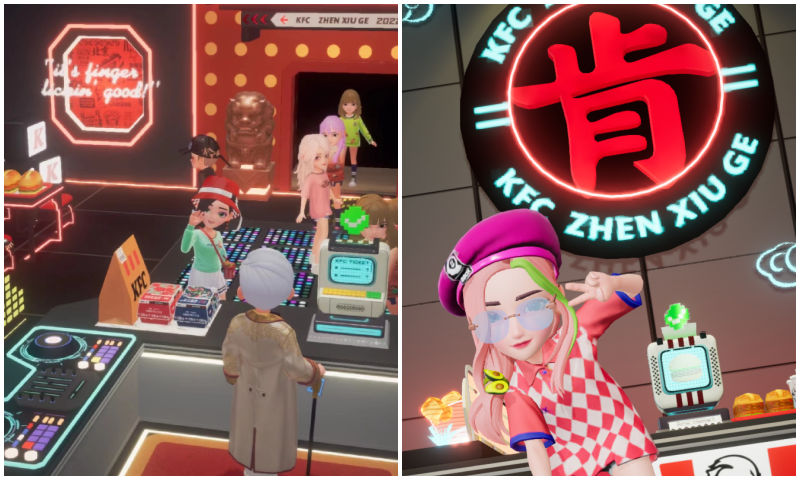
Visiting KFC in the Super QQ Show.
◼︎ In the summer of 2022, the Tencent-backed app developer company Soulgate Inc., which operates the social networking app Soul, applied to be listed on the Hong Kong Stock Exchange. Tencent is the largest shareholder holding 49.9% of the shares. Soul is a virtual social playground with the mission of “building a ‘Soul’cial Metaverse for young generations” where users can connect with other users through the virtual identity they develop in the app. The majority of its users, nearly 75%, belong to Gen-Z.
Entertainment
◼︎ On New Year’s Eve of 2021, Tencent Music Entertainment (TME) Group launched China’s first virtual social music platform TMELAND, where users can create their own avatars and interact with each other through their “digital identity.” It’s worth mentioning that TMELAND was powered by the ‘Hybrid Edge-Cloud Platform Solution’ developed by XVERSE (元象科技), which was founded by a former Tencent executive committed to building a one-stop shop for 3D content development.

Coca Cola zone in TMLAND.
Recently, Coca-Cola partnered up with TMELAND to open a new metaverse zone, accessible via the TMELAND mini-programme on WeChat.
▶︎BYTEDANCE
Known as “the world’s most valuable startup,” the Bytedance success story started with the algorithm-powered Toutiao (头条 ‘Headlines’) in 2012, a news and content platform that personalizes content for each user based on their own preferences. The Bytedance app TikTok (Douyin in China) conquered the world as one of most successful Chinese apps internationally.
Bytedance is a social networking leader, but is also focused on its in-house development in VR/AR. By 2021, Bytedance had completed at least 76 investment events, more than the previous two years combined.
From ByteDance’s activities in the XR industry, the company seems to have its strategy primarily focused on hardware, content development, and distribution across gaming, social networking, and entertainment industries.
What’s Happening?
Investments
◼︎ As early as 2018, Toutiao (Bytedance’s core product) acquired VSCENE (维境视讯) a Beijing-based solution provider for VR Live streaming.
◼︎ In July 2020, Bytedance participated in Series A funding of Seizet (熵智科技), an industrial automation company that provides a 3D industrial camera and software.
◼︎ In February 2021, Bytedance invested in Moore Threads (摩尔线程), a company that specialized in visual computing and artificial intelligence fields. In November last year, Moore Threads announced it has developed China’s first domestic full-fledged graphic processing unit (GPU) chip. Along with 5G communications, Wi-Fi 6, cloud computing, and chip technology, GPU is considered one of the main infrastructure technologies of the metaverse.
◼︎ In August 2021, ByteDance acquired Chinese VR hardware maker & software platform Pico for approximately $771 million to support its long-term investment in the VR ecosystem. By the end of Q1 2022, Pico is estimated to hold a 4.5% share of the global VR market, following Meta which is the dominant global player (90%). This year, Bytedance has set a higher sales target for Pico headsets to reach 1.6 million device output. To meet its VR industry goals, Bytedance is investing more into promotion and hiring more staff for Pico to catch up with or even surpass Meta’s Quest.
◼︎ In June 2022, ByteDance acquired PoliQ (波粒子), a team specialized in making virtual social platforms that allow users to interact with one another using their self-invented avatars in the virtual world. Jiesi Ma, the founder of PoliQ, is appointed to lead the VR Social department at ByteDance.
Research & Development
◼︎ To boost its entire VR ecosystem, Pico is engaging in more partnerships with Hollywood’s major film studios and leading streaming media companies in China (iQiyi, Youku, Tencent Video, Bilibili, and so on). In July 2022, Pico hosted Pico WangFeng@VR Music + Drifting Fantasy concert which leveraged 3D 8K VR Live Streaming technology to create a “magical” and immersive visual musical experience. By wearing Pico’s VR headsets, the audience can enjoy Wang’s performance from 5 different angles and as close as a meter away.
What’s Live?
Gaming
◼︎ On February 22, 2021, Bytedance released its game development and publishing brand Nuverse (朝夕光年). To date, Nuverse has launched several successful games through APAC and the western markets including “Burning Streetball” (热血街篮), “Houchi Shoujo” (放置少女), “Ragnarok X: Next Generation” (RO仙境传说:新世代的诞生), “Mobile Legends: Bang Bang”, and “Warhammer 40,000: Lost Crusade.”
◼︎ In April 2021, Bytedance put another US$15 million into Chinese Roblox competitor Reworld (代码乾坤), a platform for creating game worlds and playing games using the company’s own simulation engine.
Social Networking
◼︎ In September 2021, Bytedance launched its avatar app Pixsoul in Southeast Asian markets and Brazil. Users can create personalized avatars and use them to socialize.
◼︎ In January 2022, Bytedance launched a beta version of its virtual social app “Party Island” (派对岛) where users can make friends with people sharing similar interests and hang out with avatars in various virtual settings such as parks and movie theaters. However, the app was reportedly removed from app stores again and its date of relaunching is unknown.
Entertainment
◼︎ In September 2021, TikTok introduced its creator-led NFT collection titled “TikTok Top Moments” where TikTok will feature a selection of culturally-significant TikTok videos from some of the most beloved creators on the platform. Powered by Immutable X, users can ‘own’ a moment on TikTok that broke the internet and trade the TikTok Top Moments NFTs.
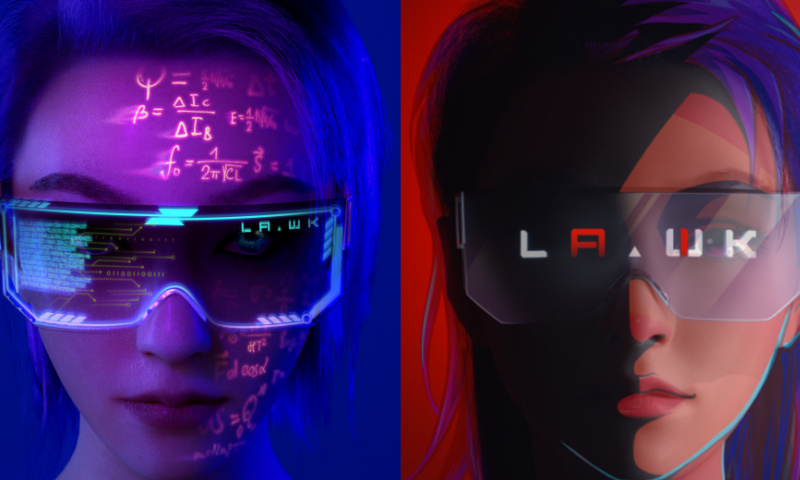
Li Weike, image via Pandaily.
◼︎ In January 2022, ByteDance bought a 20% stake in Hangzhou Li Weike Technology Co., Ltd. (Li Weike, 李未可). The company aspires to build China’s first AI+AR-powered glasses that connect users with the virtual idol Li Weike, a digital character built by the company to help users with various tasks and essentially provide users with social and emotional support.
By Jialing Xie and Manya Koetse
Follow @WhatsOnWeibo
Get the story behind the hashtag. Subscribe to What’s on Weibo here to receive our newsletter and get unlimited access to all of our articles:
Spotted a mistake or want to add something? Please let us know in comments below or email us. First-time commenters, please be patient – we will have to manually approve your comment before it appears.
©2022 Whatsonweibo. All rights reserved. Do not reproduce our content without permission – you can contact us at info@whatsonweibo.com.
Jialing is a Baruch College Business School graduate and a former student at the Beijing University of Technology. She currently works in the US-China business development industry in the San Francisco Bay Area. With a passion for literature and humanity studies, Jialing aims to deepen the general understanding of developments in contemporary China.

Also Read
China Brands, Marketing & Consumers
A Brew of Controversy: Lu Xun and LELECHA’s ‘Smoky’ Oolong Tea
Chinese tea brand LELECHA faced backlash for using the iconic literary figure Lu Xun to promote their “Smoky Oolong” milk tea, sparking controversy over the exploitation of his legacy.
Published
1 week agoon
May 3, 2024
It seemed like such a good idea. For this year’s World Book Day, Chinese tea brand LELECHA (乐乐茶) put a spotlight on Lu Xun (鲁迅, 1881-1936), one of the most celebrated Chinese authors the 20th century and turned him into the the ‘brand ambassador’ of their special new “Smoky Oolong” (烟腔乌龙) milk tea.
LELECHA is a Chinese chain specializing in new-style tea beverages, including bubble tea and fruit tea. It debuted in Shanghai in 2016, and since then, it has expanded rapidly, opening dozens of new stores not only in Shanghai but also in other major cities across China.
Starting on April 23, not only did the LELECHA ‘Smoky Oolong” paper cups feature Lu Xun’s portrait, but also other promotional materials by LELECHA, such as menus and paper bags, accompanied by the slogan: “Old Smoky Oolong, New Youth” (“老烟腔,新青年”). The marketing campaign was a joint collaboration between LELECHA and publishing house Yilin Press.
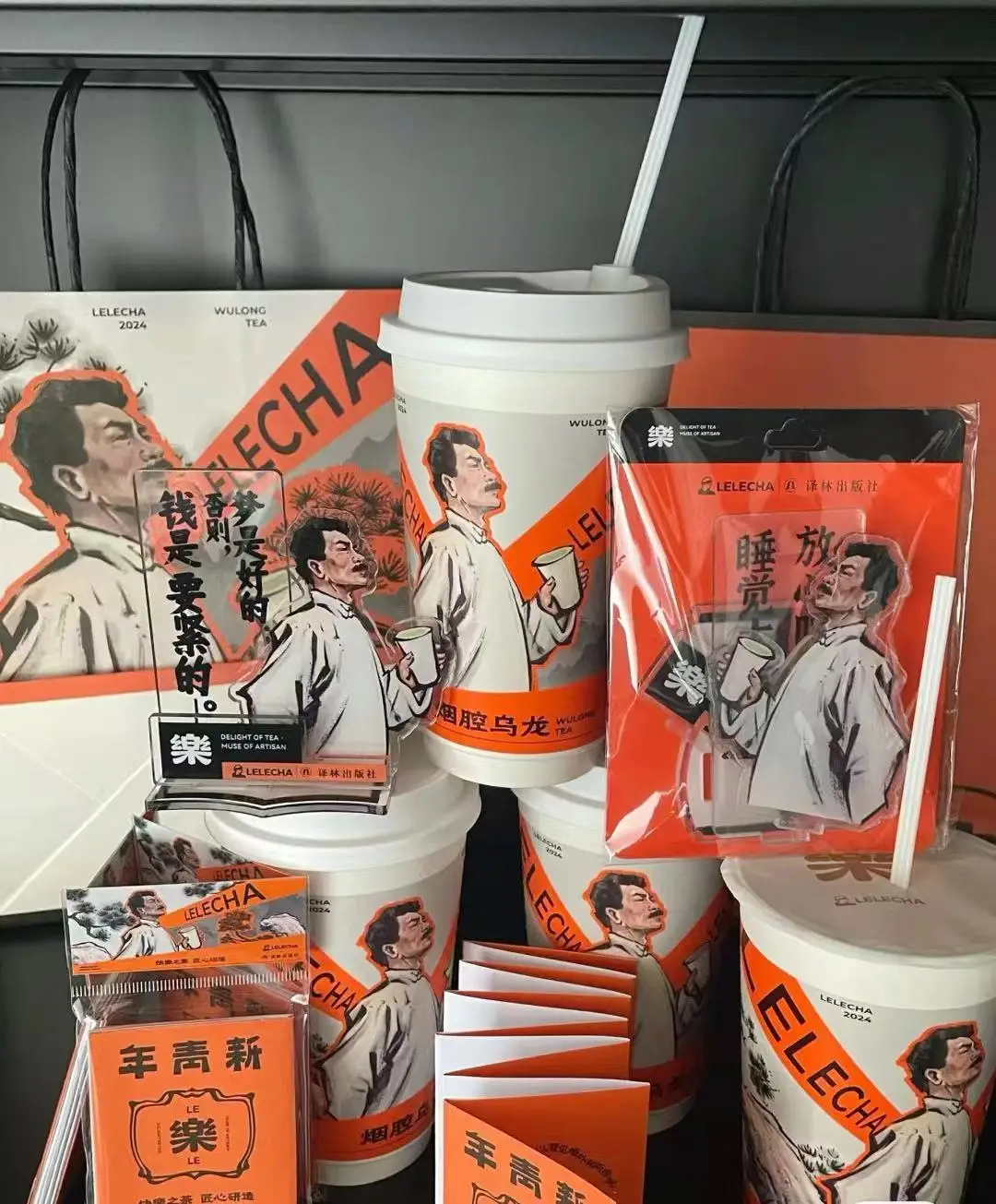
Lu Xun featured on LELECHA products, image via Netease.
The slogan “Old Smoky Oolong, New Youth” is a play on the Chinese magazine ‘New Youth’ or ‘La Jeunesse’ (新青年), the influential literary magazine in which Lu’s famous short story, “Diary of a Madman,” was published in 1918.
The design of the tea featuring Lu Xun’s image, its colors, and painting style also pay homage to the era in which Lu Xun rose to prominence.
Lu Xun (pen name of Zhou Shuren) was a leading figure within China’s May Fourth Movement. The May Fourth Movement (1915-24) is also referred to as the Chinese Enlightenment or the Chinese Renaissance. It was the cultural revolution brought about by the political demonstrations on the fourth of May 1919 when citizens and students in Beijing paraded the streets to protest decisions made at the post-World War I Versailles Conference and called for the destruction of traditional culture[1].
In this historical context, Lu Xun emerged as a significant cultural figure, renowned for his critical and enlightened perspectives on Chinese society.
To this day, Lu Xun remains a highly respected figure. In the post-Mao era, some critics felt that Lu Xun was actually revered a bit too much, and called for efforts to ‘demystify’ him. In 1979, for example, writer Mao Dun called for a halt to the movement to turn Lu Xun into “a god-like figure”[2].
Perhaps LELECHA’s marketing team figured they could not go wrong by creating a milk tea product around China’s beloved Lu Xun. But for various reasons, the marketing campaign backfired, landing LELECHA in hot water. The topic went trending on Chinese social media, where many criticized the tea company.
Commodification of ‘Marxist’ Lu Xun
The first issue with LELECHA’s Lu Xun campaign is a legal one. It seems the tea chain used Lu Xun’s portrait without permission. Zhou Lingfei, Lu Xun’s great-grandson and president of the Lu Xun Cultural Foundation, quickly demanded an end to the unauthorized use of Lu Xun’s image on tea cups and other merchandise. He even hired a law firm to take legal action against the campaign.
Others noted that the image of Lu Xun that was used by LELECHA resembled a famous painting of Lu Xun by Yang Zhiguang (杨之光), potentially also infringing on Yang’s copyright.
But there are more reasons why people online are upset about the Lu Xun x LELECHA marketing campaign. One is how the use of the word “smoky” is seen as disrespectful towards Lu Xun. Lu Xun was known for his heavy smoking, which ultimately contributed to his early death.
It’s also ironic that Lu Xun, widely seen as a Marxist, is being used as a ‘brand ambassador’ for a commercial tea brand. This exploits Lu Xun’s image for profit, turning his legacy into a commodity with the ‘smoky oolong’ tea and related merchandise.
“Such blatant commercialization of Lu Xun, is there no bottom limit anymore?”, one Weibo user wrote. Another person commented: “If Lu Xun were still alive and knew he had become a tool for capitalists to make money, he’d probably scold you in an article. ”
On April 29, LELECHA finally issued an apology to Lu Xun’s relatives and the Lu Xun Cultural Foundation for neglecting the legal aspects of their marketing campaign. They claimed it was meant to promote reading among China’s youth. All Lu Xun materials have now been removed from LELECHA’s stores.
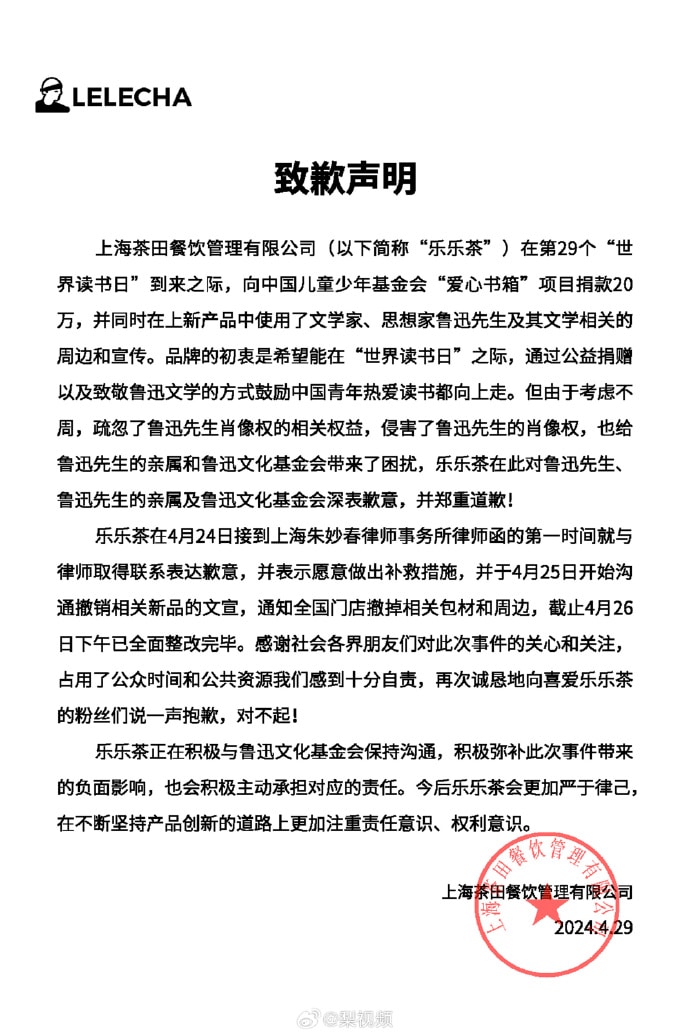
Statement by LELECHA.
On Chinese social media, where the hot tea became a hot potato, opinions on the issue are divided. While many netizens think it is unacceptable to infringe on Lu Xun’s portrait rights like that, there are others who appreciate the merchandise.
The LELECHA controversy is similar to another issue that went trending in late 2023, when the well-known Chinese tea chain HeyTea (喜茶) collaborated with the Jingdezhen Ceramics Museum to release a special ‘Buddha’s Happiness’ (佛喜) latte tea series adorned with Buddha images on the cups, along with other merchandise such as stickers and magnets. The series featured three customized “Buddha’s Happiness” cups modeled on the “Speechless Bodhisattva” (无语菩萨), which soon became popular among netizens.
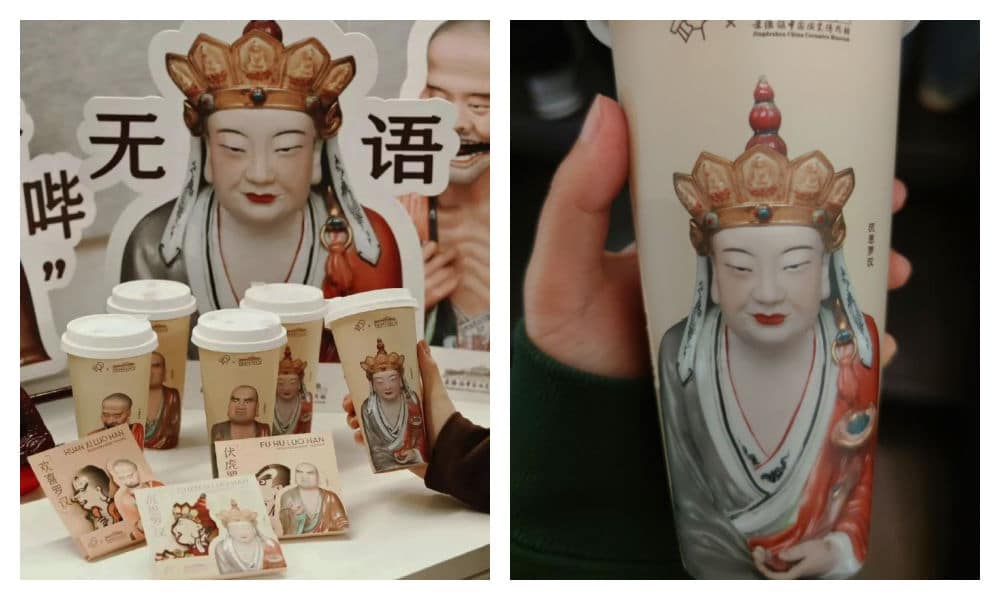
The HeyTea Buddha latte series, including merchandise, was pulled from shelves just three days after its launch.
However, the ‘Buddha’s Happiness’ success came to an abrupt halt when the Ethnic and Religious Affairs Bureau of Shenzhen intervened, citing regulations that prohibit commercial promotion of religion. HeyTea wasted no time challenging the objections made by the Bureau and promptly removed the tea series and all related merchandise from its stores, just three days after its initial launch.
Following the Happy Buddha and Lu Xun milk tea controversies, Chinese tea brands are bound to be more careful in the future when it comes to their collaborative marketing campaigns and whether or not they’re crossing any boundaries.
Some people couldn’t care less if they don’t launch another campaign at all. One Weibo user wrote: “Every day there’s a new collaboration here, another one there, but I’d just prefer a simple cup of tea.”
By Manya Koetse
[1]Schoppa, Keith. 2000. The Columbia Guide to Modern Chinese History. New York: Columbia UP, 159.
[2]Zhong, Xueping. 2010. “Who Is Afraid Of Lu Xun? The Politics Of ‘Debates About Lu Xun’ (鲁迅论争lu Xun Lun Zheng) And The Question Of His Legacy In Post-Revolution China.” In Culture and Social Transformations in Reform Era China, 257–284, 262.
Independently reporting China trends for over a decade. Like what we do? Support us and get the story behind the hashtag by subscribing:
Spotted a mistake or want to add something? Please let us know in comments below or email us. First-time commenters, please be patient – we will have to manually approve your comment before it appears.
©2024 Whatsonweibo. All rights reserved. Do not reproduce our content without permission – you can contact us at info@whatsonweibo.com.
China Brands, Marketing & Consumers
Zara Dress Goes Viral in China for Resemblance to Haidilao Apron
Who’s gonna buy this Zara dress in China? “I’m afraid that someone will say I stole the apron from Haidilao.”
Published
3 weeks agoon
April 19, 2024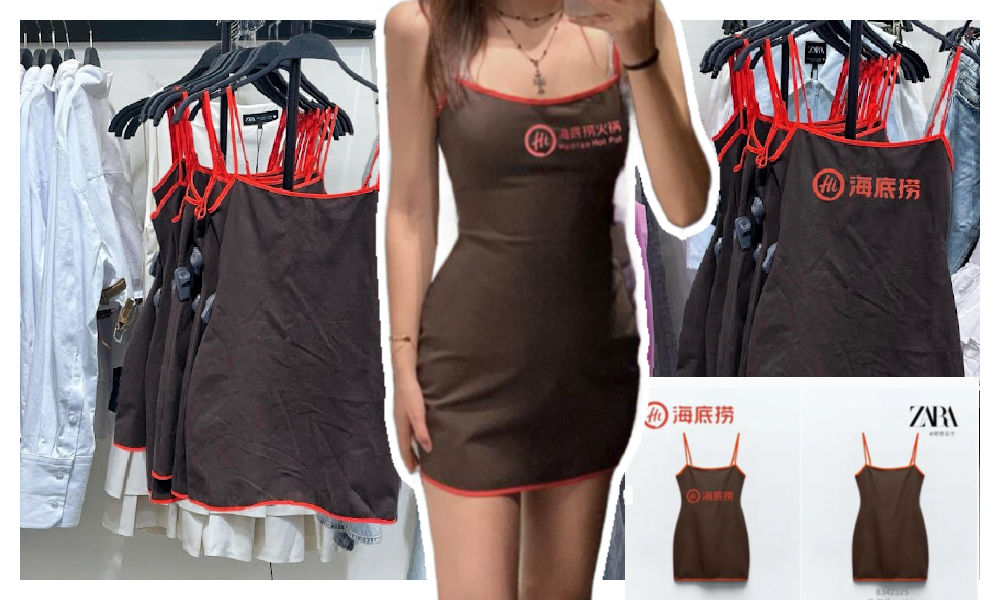
A short dress sold by Zara has gone viral in China for looking like the aprons used by the popular Chinese hotpot chain Haidilao.
“I really thought it was a Zara x Haidialo collab,” some customers commented. Others also agree that the first thing they thought about when seeing the Zara dress was the Haidilao apron.

The “original” vs the Zara dress.
The dress has become a popular topic on Xiaohongshu and other social media, where some images show the dress with the Haidilao logo photoshopped on it to emphasize the similarity.

One post on Xiaohongshu discussing the dress, with the caption “Curious about the inspiration behind Zara’s design,” garnered over 28,000 replies.
Haidilao, with its numerous restaurants across China, is renowned for its hospitality and exceptional customer service. Anyone who has ever dined at their restaurants is familiar with the Haidilao apron provided to diners for protecting their clothes from food or oil stains while enjoying hotpot.
These aprons are meant for use during the meal and should be returned to the staff afterward, rather than taken home.
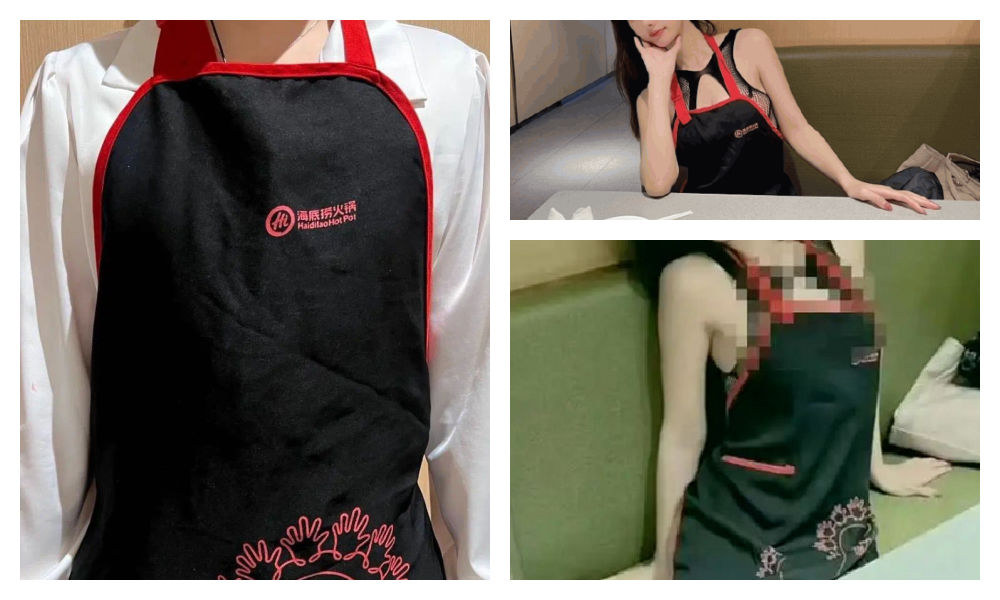
The Haidilao apron.
However, many people who have dined at Haidilao may have encountered the following scenario: after indulging in drinks and hotpot, they realize they are still wearing a Haidilao apron upon leaving the restaurant. Consequently, many hotpot enthusiasts may have an ‘accidental’ Haidilao apron tucked away at home somewhere.
This only adds to the humor of the latest Zara dress looking like the apron. The similarity between the Zara dress and the Haidilao apron is actually so striking, that some people are afraid to be accused of being a thief if they would wear it.
One Weibo commenter wrote: “The most confusing item of this season from Zara has come out. It’s like a Zara x Haidilao collaboration apron… This… I can’t wear it: I’m afraid that someone will say I stole the apron from Haidilao.”

Funnily enough, the Haidilao apron similarity seems to have set off a trend of girls trying on the Zara dress and posting photos of themselves wearing it.
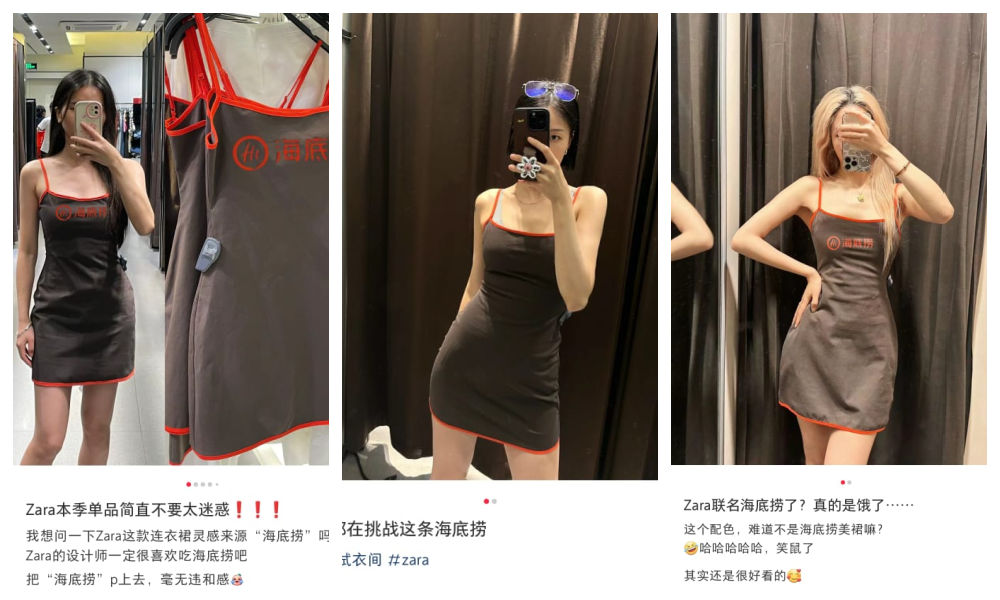
It’s doubtful that they’re actually purchasing the dress. Although some commenters say the dress is not bad, most people associate it too closely with the Haidilao brand: it just makes them hungry for hotpot.
By Manya Koetse
Independently reporting China trends for over a decade. Like what we do? Support us and get the story behind the hashtag by subscribing:
Spotted a mistake or want to add something? Please let us know in comments below or email us. First-time commenters, please be patient – we will have to manually approve your comment before it appears.
©2024 Whatsonweibo. All rights reserved. Do not reproduce our content without permission – you can contact us at info@whatsonweibo.com.
Subscribe

The Tragic Story of “Fat Cat”: How a Chinese Gamer’s Suicide Went Viral

A Brew of Controversy: Lu Xun and LELECHA’s ‘Smoky’ Oolong Tea

Weibo Watch: The Battle for the Bottom Bed

Zara Dress Goes Viral in China for Resemblance to Haidilao Apron

“Old Bull Eating Young Grass”: 86-Year-Old Chinese Painter Fan Zeng Marries 36-Year-Old Xu Meng

The ‘Two Sessions’ Suggestions: Six Proposals Raising Online Discussions

Top 9 Chinese Movies to Watch This Spring Festival Holiday

“Old Bull Eating Young Grass”: 86-Year-Old Chinese Painter Fan Zeng Marries 36-Year-Old Xu Meng

Party Slogan, Weibo Hashtag: “The Next China Will Still Be China”

From Pitch to Politics: About the Messy Messi Affair in Hong Kong (Updated)

Chengdu Disney: The Quirkiest Hotspot in China

Looking Back on the 2024 CMG Spring Festival Gala: Highs, Lows, and Noteworthy Moments

The Chinese Viral TikTok Song Explained (No, It’s Not About Samsung)

More than Malatang: Tianshui’s Recipe for Success

Two Years After MU5735 Crash: New Report Finds “Nothing Abnormal” Surrounding Deadly Nose Dive
Get in touch
Would you like to become a contributor, or do you have any tips or suggestions? Get in touch here!
Popular Reads
-

 China Insight2 months ago
China Insight2 months agoThe ‘Two Sessions’ Suggestions: Six Proposals Raising Online Discussions
-

 China Arts & Entertainment3 months ago
China Arts & Entertainment3 months agoTop 9 Chinese Movies to Watch This Spring Festival Holiday
-

 China Arts & Entertainment3 weeks ago
China Arts & Entertainment3 weeks ago“Old Bull Eating Young Grass”: 86-Year-Old Chinese Painter Fan Zeng Marries 36-Year-Old Xu Meng
-

 China Media2 months ago
China Media2 months agoParty Slogan, Weibo Hashtag: “The Next China Will Still Be China”



